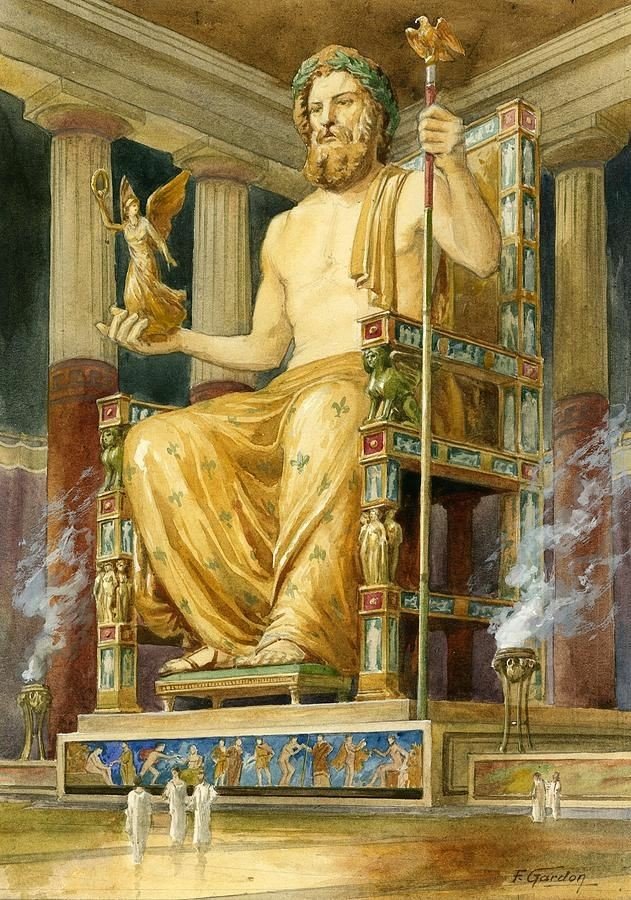
Fuente
Título: Manifestaciones del ingenio humano: las siete maravillas del mundo antiguo. (II Parte) Por Florencia Renata.
Aviso: pueden leer la primera parte de este artículo en el siguiente enlace

Fuente
Jardines colgantes de Babilonia, actual Irak:
Es una de las maravillas a la que el misterio le envuelve, muchos creen que se trató de un lugar ilusorio. Sin embargo, se consideró como la mayor de las maravillas de Babilonia. Hay muchas versiones sobre cómo era o dónde se encontraba, e incluso en honor a quién o quiénes lo hicieron.
Aunque los datos más acertados sobre estos jardines, son que ocupaban una dos mil hectáreas de terrenos elevados, sostenidos por arcos que variaban entre los 23 y los 91 metros de altura, y se encontraban dentro de los terrenos pertenecientes al palacio del rey Nabucodonosor.
Se cuenta que se plantaron emparrados e hileras de árboles que formaban pasillos y por todas partes se podían admirar una gran variedad de flores más fragantes y apreciadas de la época. Sin duda el detalle más significativo fue el sistema de riego con el que contó para que todo el jardín se mantuviera siempre verde, el rey Nabucodonosor mandó a colocar en la parte más elevada un gran depósito que se llenaba de agua procedente del río Eufrates. Lamentablemente no se cuenta con un registro real sobre su existencia.

Fuente
Estatua de Zeus, Olimpia, Grecia:
Zeus era considerado como el padre de los dioses por los antiguos griegos , señor absoluto del mundo y el que abría el camino de la razón a los hombres. Mientras que Fideas fue un famoso escultor, fundidor, orfebre y grabador de metal, procedente de Grecia, vivió en el siglo V aC.
Se considera que esta estatua fue la gran obra de Fideas. Le fue encargado para el santuario de Zeus erigido en la ciudad de Olimpia; para ello cinceló la estatua del padre de los dioses, una figura de 13 metros de altura, que se encontraba sentada en un trono de ébano, bronce, marfil, oro y piedras preciosas.
El rostro contaba con una densa barba rizada, y en su mano derecha sujetaba a la Victoria, y en la izquierda sostenía el cetro con un águila. Fue destruido por un incendio en el año 475 d.C.
Continuará…

Fuente
Title: Manifestations of human ingenuity: the seven wonders of the ancient world. (Part II) By Florencia Renata.
Notice: you can read the first part of this article at the following link

Fuente
Hanging Gardens of Babylon, present-day Iraq:
It is one of the wonders to which the mystery surrounds it, many believe that it was an illusory place. However, it was considered to be the greatest of the wonders of Babylon. There are many versions about what it was like or where it was located, and even in honor of whom or who made it.
Although the most accurate data about these gardens are that they occupied about two thousand hectares of high ground, supported by arches that varied between 23 and 91 meters high, and were located within the grounds belonging to the palace of King Nebuchadnezzar.
It is said that vines and rows of trees were planted that formed corridors and everywhere you could admire a great variety of the most fragrant and appreciated flowers of the time. Undoubtedly the most significant detail was the irrigation system with which he counted so that the entire garden remained always green, King Nebuchadnezzar ordered to place in the highest part a large reservoir that was filled with water from the Euphrates River. Unfortunately, there is no real record of its existence.

Fuente
Statue of Zeus, Olympia, Greece:
Zeus was considered as the father of the gods by the ancient Greeks, absolute lord of the world and the one who opened the way of reason to men. While Fideas was a famous sculptor, foundry, goldsmith and metal engraver, coming from Greece, he lived in the fifth century BC.
This statue is considered to have been the great work of Fideas. He was commissioned for the sanctuary of Zeus erected in the city of Olympia; for this he chiseled the statue of the father of the gods, a figure 13 meters high, which was sitting on a throne of ebony, bronze, ivory, gold and precious stones.
The face had a dense curly beard, and in his right hand he held Victory, and in the left he held the scepter with an eagle. It was destroyed by fire in 475 A.D.
Continue...
Babylon always fascinates me... It's one of the earliest civilizations recorded in history, yet, it's one of the few ones that has wonders left from it to this day. Egypt is a close second!
!PIZZA !LUV
@flormarsal, @ahmadmanga(3/10) sent you LUV. | tools | discord | community | HiveWiki | NFT | <>< daily
NFT | <>< daily
I gifted $PIZZA slices here:
@ahmadmanga(4/15) tipped @flormarsal (x1)
Send $PIZZA tips in Discord via tip.cc!